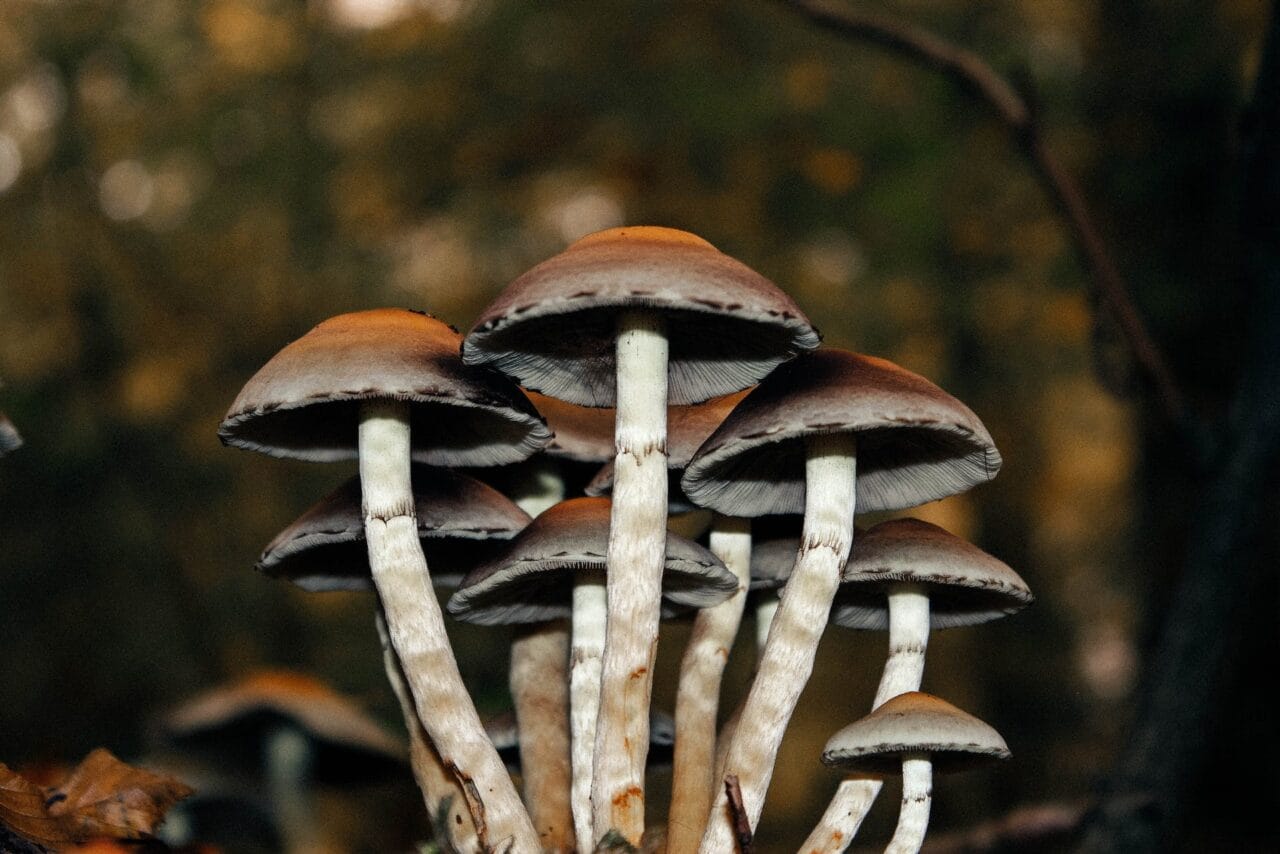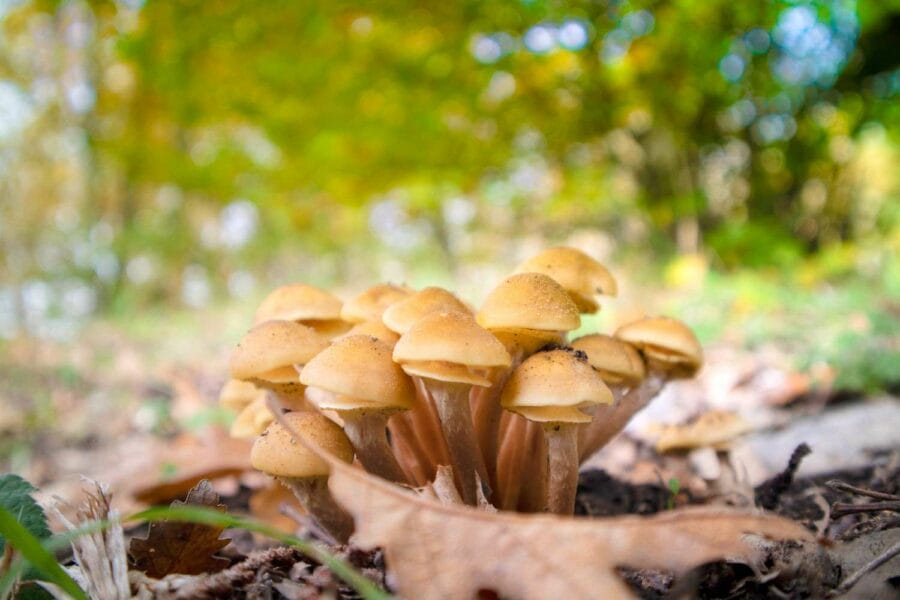Psilocybin is a psychoactive substance found in magic mushrooms, commonly used for recreational purposes to induce euphoria and hallucinations.
Beyond its mind-altering properties, research has been conducted into the compound’s potential benefits for relieving chronic pain.
This piece discusses a case study that investigates how mushroom microdosing may assist in mitigating chronic pain.
Key Takeaways:
- Potential for both immediate and long-lasting pain alleviation through mushroom microdosing.
- Compared to traditional pain medications, psilocybin microdosing typically exhibits fewer side effects when administered in small doses.
- Psilocybin interacts with serotonin 2A (5-HT2A) receptors, potentially easing pain and other conditions.

The Study
Dr. Matthew Lyes and his team from the Division of Pain Medicine in the Department of Anesthesiology at the University of California, San Diego, conducted the study “Microdosing Psilocybin for Chronic Pain: A Case Series“. Their research focused on three patients who self-administered small doses of psilocybin to manage their chronic pain symptoms.
Three Patients, One Result – Chronic Pain Reduction
Patient # 1
| AGE/ GENDER: | 37 Male |
| PAIN TYPE: | Neuropathic pain appearing below a spinal cord injury site. |
| PAIN INTENSITY: | Initially 4 to 5/ 10, increasing to 8/ 10 later in the day |
| PSILOCYBIN DOSE: | 250 mg of ground mushroom for less than 6 months |
| OUTCOME: | Discontinuation of prescribed pain medication, reduced muscle spasms, and improved bowel movement efficiency. No signs of rebound pain or withdrawal symptoms. |
| The patient noted that while his usual medications only managed to dull the pain, psilocybin effectively eliminated it, reducing his average pain level from 5 to 0. | |
Case Study: Subject #2
| AGE/ GENDER: | 69-year-old Female |
| TYPE OF PAIN: | Complex Regional Pain Syndrome (CRPS) |
| INTENSITY OF PAIN: | Typically varies between 5 to 7 out of 10, heightened during activity and pain flare-ups |
| PSILOCYBIN DOSAGE: | Regular intake of 500 mg for periods of 7 to 10 days with breaks (2 to 3 days) throughout a year. Dosage ramps up to 750 mg to 1 gram during periods of pain intensification |
| IMPACT: | Pain decreases by 80% for a duration of 3-4 hours, slowly returning to original levels after a span of 12 hours. Complete pain alleviation (90%-100%) persists for 6-8 hours, reverting to original levels after 18 hours. |
| The subject experiences a decline in hunger without associated nausea. Disorientation or unsteadiness while walking is observed when the dose is increased (750 to 1000mg). | |
Case Study: Subject # 3
| AGE/ GENDER: | 40-year-old Female |
| TYPE OF PAIN: | Lumbar radiculopathy and neuropathic discomfort |
| INTENSITY OF PAIN: | 8 out of 10, escalating to a full 10 during physical activity |
| PSILOCYBIN DOSAGE: | 1000 mg from a mushroom-infused chocolate bar every two months. |
| IMPACT: | Significant pain relief without any mind-altering effects. Observed improvement in flexibility and functionality. Pain slowly reverts to original levels over a period of 2-4 weeks. Recurring dosage enhances control over pain. |
| The subject does not indicate any significant physical, cognitive, or behavioural side effects. Her mood remains predominantly stable. She maintains her routine dosage of her SSRI for managing depression throughout the psilocybin treatment period. | |
Understanding the Role of Psilocybin in Pain Management
Persistent somatic and visceral pain signals strengthen specific neural pathways due to peripheral and central sensitization, resulting in a chronic perception of pain both physically and emotionally. Psychedelics like psilocybin stimulate 5-HT2A receptors, potentially resetting the brain regions associated with neuropathic conditions.
A patient reported enduring pain relief for several weeks. This suggests that direct stimulation of the 5-HT2A receptors can lead to a central regulation of pain perception and
The adaptability of synapses.
Potential Side Effects: Psilocybin vs. Traditional Pain Relievers
| PSILOCYBIN (Research-Based) | TRADITIONAL PAIN RELIEVERS |
| Muscle spasms | Nausea |
| Decreased appetite | Stomach discomfort |
| Confusion | Migraines |
| Impaired balance | Dependency |
| No change in mood | Drowsiness |
Potential Areas for Future Psilocybin Research
The research team has identified several areas for further study based on the experiences of three individuals, due to their potential benefits.
- Small psilocybin doses might provide immediate and perhaps lasting relief from neuropathic pain, without causing physical tolerance or dependency.
- Examine the outcomes of different treatment approaches in combination with psilocybin. For example, patient #3 reported an increased pain-relieving effect when psilocybin was used with physical therapy.
- Even without psychotherapy, small psilocybin doses may alleviate pain, as demonstrated in this case study. The researchers suggest that combining therapeutic guidance could possibly enhance or extend the therapeutic effects.
Study Limitations
Despite the encouraging outcomes in the patients, it’s important to acknowledge the limitations identified in the study.
- The small sample size may not accurately reflect the experiences of all individuals with neuropathic pain.
- The study did not include any participants who did not respond to psilocybin.
- The study did not conduct evaluations before and after the treatment to measure the impact of psilocybin on psychiatric disorders such as depression and anxiety.
- Most of the data was self-reported by the participants.
- The presence of the interviewer and potential bias towards psilocybin could have influenced the participants’ responses.
- The study did not consider the influence of the placebo effect.
- The study did not measure the psilocybin concentration in each mushroom.
Microdosing Psilocybin Mushrooms
In this research, Patients #1 and #2 consumed a microdose of psilocybin in a powdered form that originated from dehydrated mushrooms, whereas patient #3 combined it with chocolate. There’s a wide range of products specially designed for psilocybin microdosing, and we’ve gathered a selection of them below.
Dehydrated Mushrooms
Even though the specific strain used in the study wasn’t mentioned, the following strain is an excellent choice for those starting their journey.
- Golden Teacher: This strain is one of the most prevalent and widely recognized magic mushrooms.
- Amazonian Cubensis: This strain is known for its user-friendliness and potential cognitive benefits.
- Cambodian: Microdosing with Cambodian cubensis mushrooms can potentially improve focus, social awareness, and mood.
Microdose Capsules
- Euphoria Psychedelics – Micro Calm Capsules: This formulation contains Ashwagandha, Reishi, CBD, Valerian root, and Psilocybin Mushrooms. All these ingredients are scientifically demonstrated to alleviate anxiety and stress.
- Ground Sounds – Microdose Capsules – Champion Lover: This captivating blend offers three dosage options: 50mg, 100mg, or 250mg of pure psilocybin combined with reishi, cacao, cordyceps, and maca.
- Kind Stranger – Brighten Capsules 250mg: These capsules utilize the Golden Teacher strain, renowned for promoting mental clarity, enhanced creativity, and increased focus.
Pain Management with Psilocybin
While the research on mushrooms’ analgesic effects is still nascent, anecdotal reports and small-scale case studies are generating optimism.
Such instances underscore the need for further exploration into the potential advantages of psilocybin, class=”wp-block-list”>
What are the potential drawbacks?
Microdosing mushrooms may lead to unintended side effects such as hallucinations, paranoia, and anxiety. It’s also not recommended for people with a history of psychosis, schizophrenia, or severe anxiety. Always consult with a healthcare professional before starting a microdosing regimen.
Can it be used in chronic pain management?
Yes, there is growing evidence suggesting that psilocybin can be a useful tool in managing chronic pain, particularly when traditional pain management strategies have been ineffective.
The wider acceptance of psilocybin as a pain relief agent is largely due to promising findings from case studies, providing a glimmer of hope for those living with chronic pain.
Frequently Asked Questions
What are the effects of microdosing psilocybin?
Psilocybin primarily activates a serotonin receptor known as “5-HT2A” in the prefrontal cortex, which results in two primary impacts:
- Stimulation of “Brain-Derived Neurotrophic Factor” (BDNF) production
- Enhancement of “Glutamate” transmission
Moreover, psychedelics foster connections between brain regions that typically do not interact. This unique neural connectivity is a product of the ability of psychedelics to decrease the activity of the “Default Mode Network” (DMN), a network associated with various cognitive functions, including daydreaming, introspection, and reflecting on the past and future.
What is the most significant benefit of microdosing mushrooms?
Microdosing may potentially enhance mood, productivity, creativity, and focus. Its most extensively documented benefit is its positive effect on mental health.
In November 2022, the mental health company, COMPASS Pathways, unveiled the results of their thorough phase 2b trial, a randomized and double-blind study. Their findings indicated that a single dose of psilocybin resulted in remarkable reductions in depressive symptoms in comparison to a placebo. Participants who received a higher dose of 25 milligrams maintained an antidepressant response at the follow-up after twelve weeks.
A study published in the Psychiatry Research Journal suggested that psilocybin is more effective than traditional antidepressant treatments.
How can one determine the right dosage?
Begin with a 0.1-gram dose of psilocybin mushrooms on the first day. If the effects are not as desired, gradually increase the dose by 0.05 grams on subsequent microdosing days until you reach the desired level.
Those with prior experience with psychotropic drugs may need to adjust the dose to 0.5 grams to achieve the desired effects.
What precautions should be taken before consuming mushrooms?
class=”wp-block-list”>What is the advised frequency for taking microdoses of mushrooms?
Several well-founded protocols propose structured microdosing plans for psychedelics. The main difference between these protocols lies in the number of “off” days they suggest, which are the days you abstain from microdosing.
The most widely suggested protocols recommend incorporating 1-3 days of break between microdoses. This aligns with the body’s natural tolerance mechanisms. The three protocols under discussion in this context are the Fadiman Protocol, the Stamets Stack, and intuitive microdosing.




